Monitoring of Extreme Drought in the Yangtze River Basin in 2022 Based on Multi-Source Remote Sensing Data
Abstract
1. Introduction
1.1. Drought
1.2. GRACE
1.3. Drought Monitoring Using GRACE
2. Study Area, Data and Methods
2.1. Study Area
2.2. Data Sources and Processing
2.2.1. GRACE-TWSA
2.2.2. SPI, SPEI
2.2.3. GLDAS Data
2.2.4. CLDAS Data
2.3. Methods of Analysis
GRACE-DSI
3. Results
3.1. Analyses Based on Terrestrial Water Storage Anomalies
3.2. Analyses Based on Changes in Abnormal Soil Moisture
3.3. Relative Soil Moisture Analysis
3.4. Analysis Based on Drought Indices
3.5. Comparative Analysis of Soil Moisture Products and Validation of Measured Site Data
4. Discussion
4.1. Difference between Meteorological and Hydrological Drought
4.2. Hydrological Variables’ Response to the Drought
4.3. Assumptions and Limitations of Using GRACE in Different Parts of Yangtze Basin
4.4. Possible Future Direction
5. Conclusions
- (1)
- The terrestrial water storage change can well reflect the water storage change in the Yangtze River Basin. The overall trend of terrestrial water storage change in the middle and upper reaches of the Yangtze River Basin is smaller than the negative anomaly, while the negative anomaly in the middle and lower reaches of the Yangtze River Basin is larger, and the negative anomaly is larger in most areas of the Yangtze River Basin with the passage of time. The average change in terrestrial water storage in the Yangtze River Basin for the whole year was above the mean value of 33.47 mm in January–June and below the mean value of 48.17 mm in July–December.
- (2)
- The GRACE-DSI well reflects the beginning and end of the 2022 mega-drought in the Yangtze River Basin, with the drought event gradually expanding from the northern part of Jiangxi Province in August, and the drought area expanding over time with increasing drought severity, and finally shifting to Hubei Province. The area of extreme drought of different levels in the Yangtze River Basin showed a trend of increasing and then decreasing, with the largest extreme drought area of 85.69 km2 in September.
- (3)
- The GRACE-DSI, as a drought index calculated based on gravity satellite data, correlates well with the standardized precipitation index SPI and the standardized precipitation evapotranspiration index SPEI, with correlation coefficients above 0.75, of which the highest correlation with the SPEI3 dataset is 0.93, which reflects the ability of the GRACE gravity satellites to provide more accurate descriptions of extreme drought events.
- (4)
- By comparing the soil moisture products of the GLDAS and CLDAS, and adding the validation of measured site data, it was verified that after the drought in August, there was a trend of sudden decrease in soil moisture content in the Yangtze River Basin, and the soil moisture content was at a lower level after that; it was expected to recover in the first half of 2023.
Author Contributions
Funding
Data Availability Statement
Acknowledgments
Conflicts of Interest
References
- Ault, T.R. On the essentials of drought in a changing climate. Science 2020, 368, 256–260. [Google Scholar] [CrossRef] [PubMed]
- Lu, H.; Zhang, X.Y.; Liu, S.D. Risk assessment to China’s agricultural drought disaster in county unit. Nat. Hazards 2012, 61, 785–801. [Google Scholar] [CrossRef]
- Yang, Q.; Li, M.X.; Zheng, Z.Y.; Ma, Z. Regional applicability of seven meteorological drought indices in China. Sci. China Earth Sci. 2017, 47, 337–353. (In Chinese) [Google Scholar] [CrossRef]
- Van Dijk, A.I.J.M.; Beck, H.E.; Crosbie, R.S.; De Jeu, R.A.; Liu, Y.Y.; Podger, G.M.; Timbal, B.; Viney, N.R. The Millennium Drought in southeast Australia (2001−2009): Natural and human causes and implications for water resources, ecosystems, economy, and society. Water Resour. Res. 2013, 49, 1040–1057. [Google Scholar] [CrossRef]
- Van Loon, A.F.; Gleeson, T.; Clark, J.; Van Dijk, A.I.; Stahl, K.; Hannaford, J.; Di Baldassarre, G.; Teuling, A.J.; Tallaksen, L.M.; Uijlenhoet, R.; et al. Drought in the Anthropocene. Nat. Geosci. 2016, 9, 89–91. [Google Scholar] [CrossRef]
- Hasan, E.; Tarhule, A.; Hong, Y.; Moore, B., III. Assessment of physical water scarcity in Africa using GRACE and TRMM satellite data. Remote Sens. 2019, 11, 904. [Google Scholar] [CrossRef]
- Feng, W.; Zhong, M.; Lemoine, J.M.; Biancale, R.; Hsu, H.T.; Xia, J. Evaluation of groundwater depletion in North China using the Gravity Recovery and Climate Experiment(GRACE) data and ground-based measurements. Water Resour. Res. 2013, 49, 2110–2118. [Google Scholar] [CrossRef]
- Joodaki, G.; Wahr, J.; Swenson, S. Estimating the human contribution to groundwater depletion in the Middle East, from GRACE data, land surface models, and well observations. Water Resour. Res. 2014, 50, 2679–2692. [Google Scholar] [CrossRef]
- Sun, Z.; Zhu, X.; Pan, Y.; Zhang, J.; Liu, X. Drought evaluation using the GRACE terrestrial water storage deficit over the Yangtze River Basin, China. Sci. Total Environ. 2018, 634, 727–738. [Google Scholar] [CrossRef]
- Chen, J.L.; Wilson, C.R.; Tapley, B.D.; Yang, Z.L.; Niu, G.Y. 2005 drought event in the Amazon River basin as measured by GRACE and estimated by climate models. J. Geophys. Res. Solid Earth 2009, 114, B05404. [Google Scholar] [CrossRef]
- Feng, W.; Lemoine, J.M.; Zhong, M.; Hsu, T.T. Terrestrial water storage changes in the Amazon basin measured by GRACE during 2002—2010. Chin. J. Geophys. 2012, 55, 814–821. [Google Scholar] [CrossRef]
- Chen, J.L.; Wilson, C.R.; Tapley, B.D.; Longuevergne, L.; Yang, Z.L.; Scanlon, B.R. Recent La Plata basin drought conditions observed by satellite gravimetry. J. Geophys. Res. Atmos. 2010, 115, D22108. [Google Scholar] [CrossRef]
- Long, D.; Shen, Y.; Sun, A.; Hong, Y.; Longuevergne, L.; Yang, Y.; Li, B.; Chen, L. Drought and flood monitoring for a large karst plateau in Southwest China using extended GRACE data. Remote Sens. Environ. 2014, 155, 145–160. [Google Scholar] [CrossRef]
- Yirdaw, S.Z.; Snelgrove, K.R.; Agboma, C.O. GRACE satellite observations of terrestrial moisture changes for drought characterization in the Canadian Prairie. J. Hydrol. 2008, 356, 84–92. [Google Scholar] [CrossRef]
- Yi, H.; Wen, L. Satellite gravity measurement monitoring terrestrial water storage change and drought in the continental United States. Sci. Rep. 2016, 6, 19909. [Google Scholar] [CrossRef] [PubMed]
- Zhao, M.; Geruo, A.; Velicogna, I.; Kimball, J.S. A global gridded dataset of GRACE drought severity index for 2002–14: Comparison with PDSI and SPEI and a case study of the Australia millennium drought. J. Hydrometeorol. 2017, 18, 2117–2129. [Google Scholar] [CrossRef]
- Liu, X.; Feng, X.; Ciais, P.; Fu, B.; Hu, B.; Sun, Z. GRACE satellite-based drought index indicating increased impact of drought over major basins in China during 2002–2017. Agric. For. Meteorol. 2020, 291, 108057. [Google Scholar] [CrossRef]
- Wang, F.; Wang, Z.; Yang, H.; Di, D.; Zhao, Y.; Liang, Q. Utilizing GRACE-based groundwater drought index for drought characterization and teleconnection factors analysis in the North China Plain. J. Hydrol. 2020, 585, 124849. [Google Scholar] [CrossRef]
- Han, Z.; Huang, S.; Huang, Q.; Leng, G.; Liu, Y.; Bai, Q.; He, P.; Liang, H.; Shi, W. GRACE-based high-resolution propagation threshold from meteorological to groundwater drought. Agric. For. Meteorol. 2021, 307, 108476. [Google Scholar] [CrossRef]
- Cui, A.; Li, J.; Zhou, Q.; Zhu, R.; Liu, H.; Wu, G.; Li, Q. Use of a multiscalar GRACE-based standardized terrestrial water storage index for assessing global hydrological droughts. J. Hydrol. 2021, 603, 126871. [Google Scholar] [CrossRef]
- Rawat, S.; Ganapathy, A.; Agarwal, A. Drought characterization over Indian sub-continent using GRACE-based indices. Sci. Rep. 2022, 12, 15432. [Google Scholar] [CrossRef] [PubMed]
- Foroumandi, E.; Nourani, V.; Huang, J.J.; Moradkhani, H. Drought monitoring by downscaling GRACE-derived terrestrial water storage anomalies: A deep learning approach. J. Hydrol. 2023, 616, 128838. [Google Scholar] [CrossRef]
- Han, Z.; Huang, S.; Peng, J.; Li, J.; Leng, G.; Huang, Q.; Zhao, J.; Yang, F.; He, P.; Meng, X.; et al. GRACE-based dynamic assessment of hydrological drought trigger thresholds induced by meteorological drought and possible driving mechanisms. Remote Sens. Environ. 2023, 298, 113831. [Google Scholar] [CrossRef]
- Zhong, Y.; Hu, E.; Wu, Y.; An, Q.; Wang, C.; Bai, H.; Gao, W. Reconstructing a long-term water storage-based drought index in the Yangtze River Basin. Sci. Total Environ. 2023, 883, 163403. [Google Scholar] [CrossRef] [PubMed]
- Shi, M.Q.; Yuan, Z.; Shi, X.L.; Li, Y.; Chen, F. Spatial and Temporal Variation Characteristics of Blue and Green Water Resources in the Yangtze River Basin Based on GLDAS-NOAH. J. Yangtze River Sci. Res. Inst. 2022, 39, 38. [Google Scholar] [CrossRef]
- Liu, J.; Yuan, Z.; Xu, J.; Liu, Y.Y.; Cheng, W.S.; Tian, C.W.; Miao, H.L. Meteorological drought evolution characteristics and future trends in the Yangtze river basin. J. Yangtze River Sci. Res. Inst. 2020, 37, 28. [Google Scholar] [CrossRef]
- Ding, H.; Shi, X.L.; Wu, M.Y. Terrestrial water storage anomaly in the Yellow River Basin based on GRACE gravity satellite data. Water Resour. Water Eng. J. 2021, 32, 109–115. [Google Scholar]
- Li, X.; Zhong, B.; Li, J.; Liu, R. Analysis of terrestrial water storage changes in the Shaan-Gan-Ning Region using GPS and GRACE/GFO. Geod. Geodyn. 2022, 13, 179–188. [Google Scholar] [CrossRef]
- Scanlon, B.R.; Zhang, Z.; Save, H.; Wiese, D.N.; Landerer, F.W.; Long, D.; Longuevergne, L.; Chen, J. Global evaluation of new GRACE mascon products for hydrologic applications. Water Resour. Res. 2016, 52, 9412–9429. [Google Scholar] [CrossRef]
- Palmer, W.C. Meteorological Drought Research; Paper No. 45; US Weather Bureau: Washington, DC, USA, 1965.
- Dai, A. Characteristics and trends in various forms of the Palmer Drought Severity Index during 1900–2008. J. Geophys. Res. Atmos. 2011, 116, D12115. [Google Scholar] [CrossRef]
- McKee, T.B.; Doesken, N.J.; Kleist, J. The Relationship of Drought Frequency and Duration to Time Scales. In Proceedings of the 8th Conference on Applied Climatology, Anaheim, CA, USA, 17–22 January 1993; Volume 17, pp. 179–183. [Google Scholar]
- Ni, N.Q.; Xie, J.X.; Liu, X.M.; Wang, K.W.; Tian, W. Multi-source data quality assessment based on the index of runoff sensitivity to climate change. Acta Geogr. Sin. 2022, 77, 2280–2291. [Google Scholar] [CrossRef]
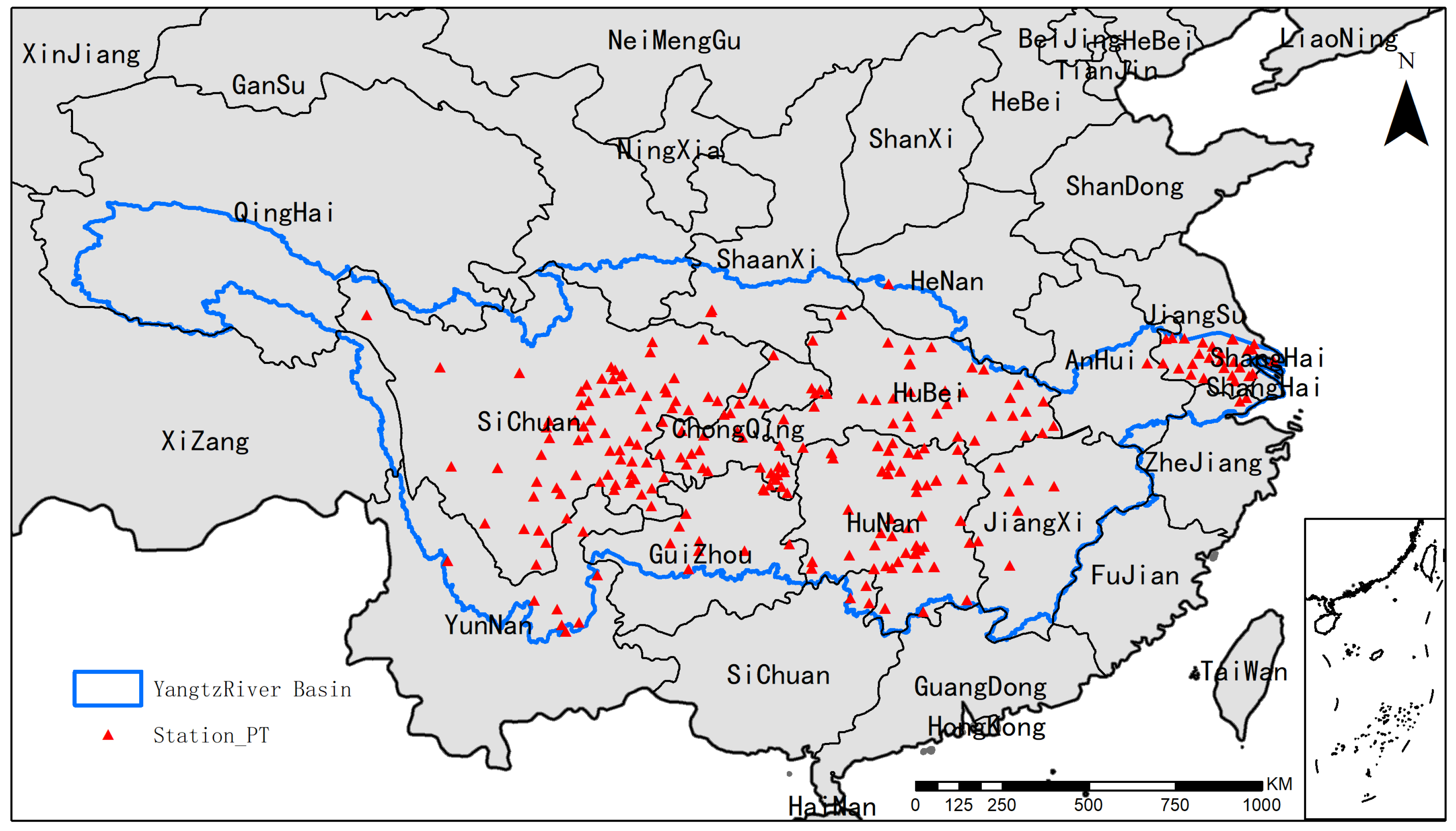

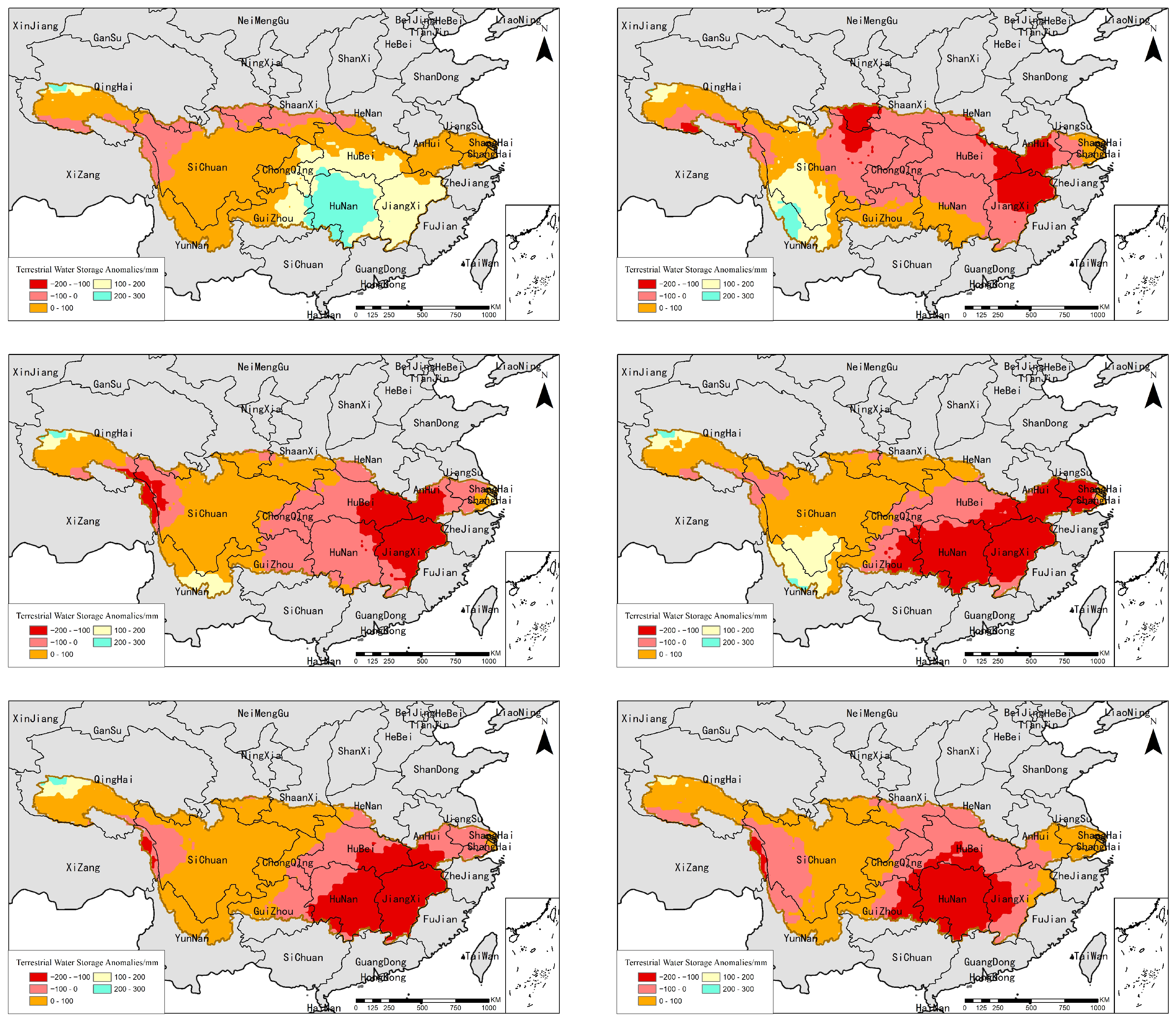
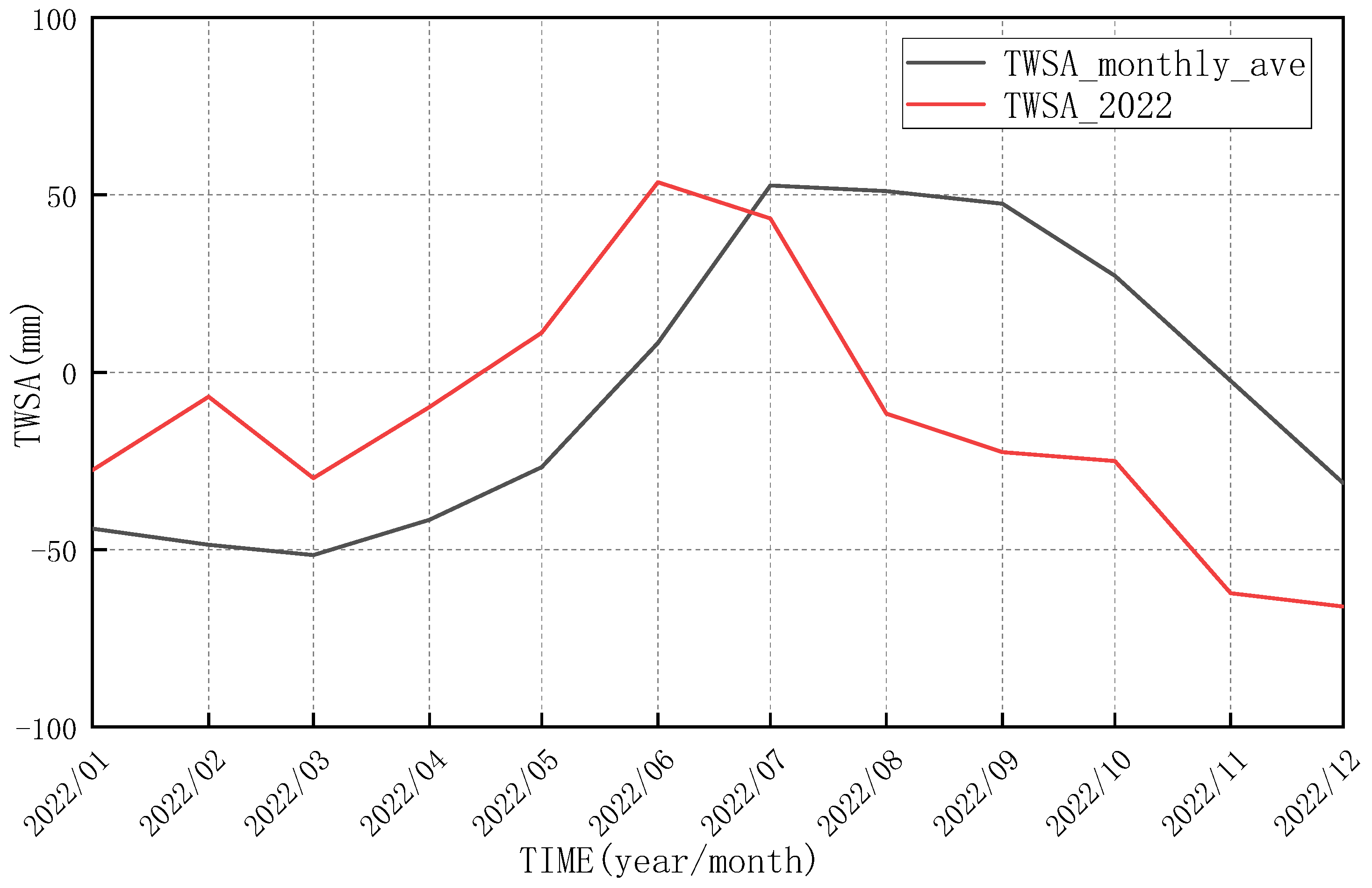
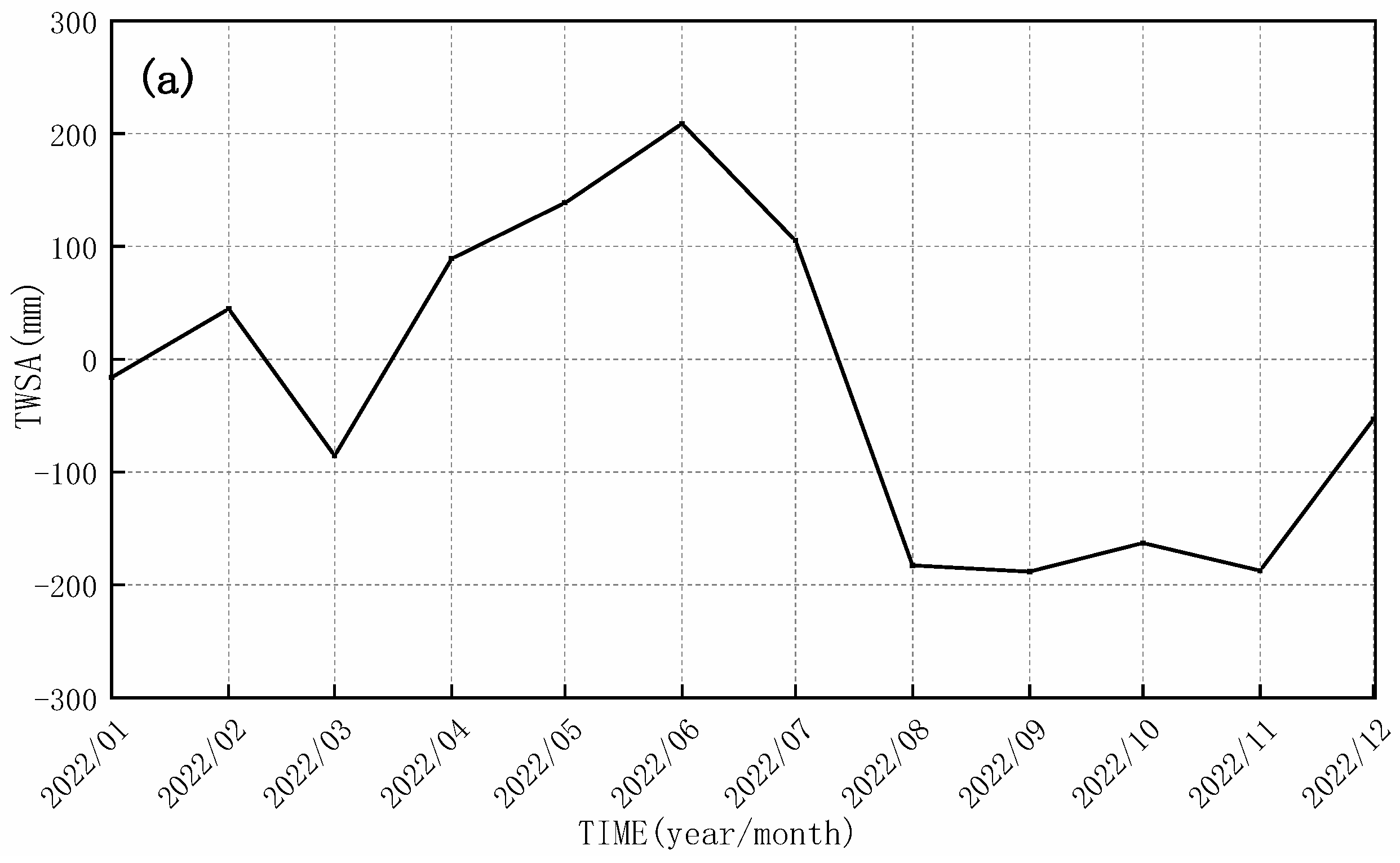
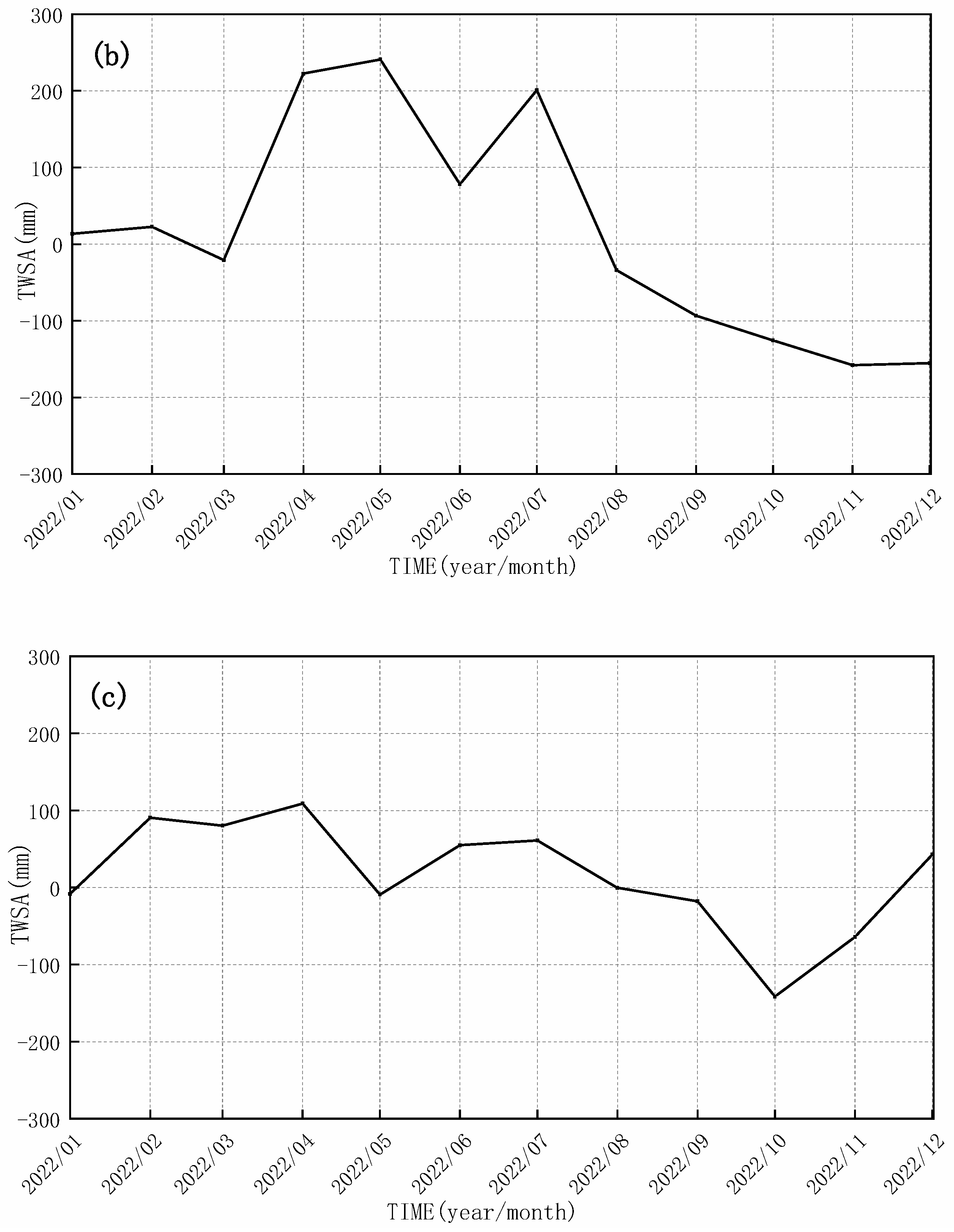
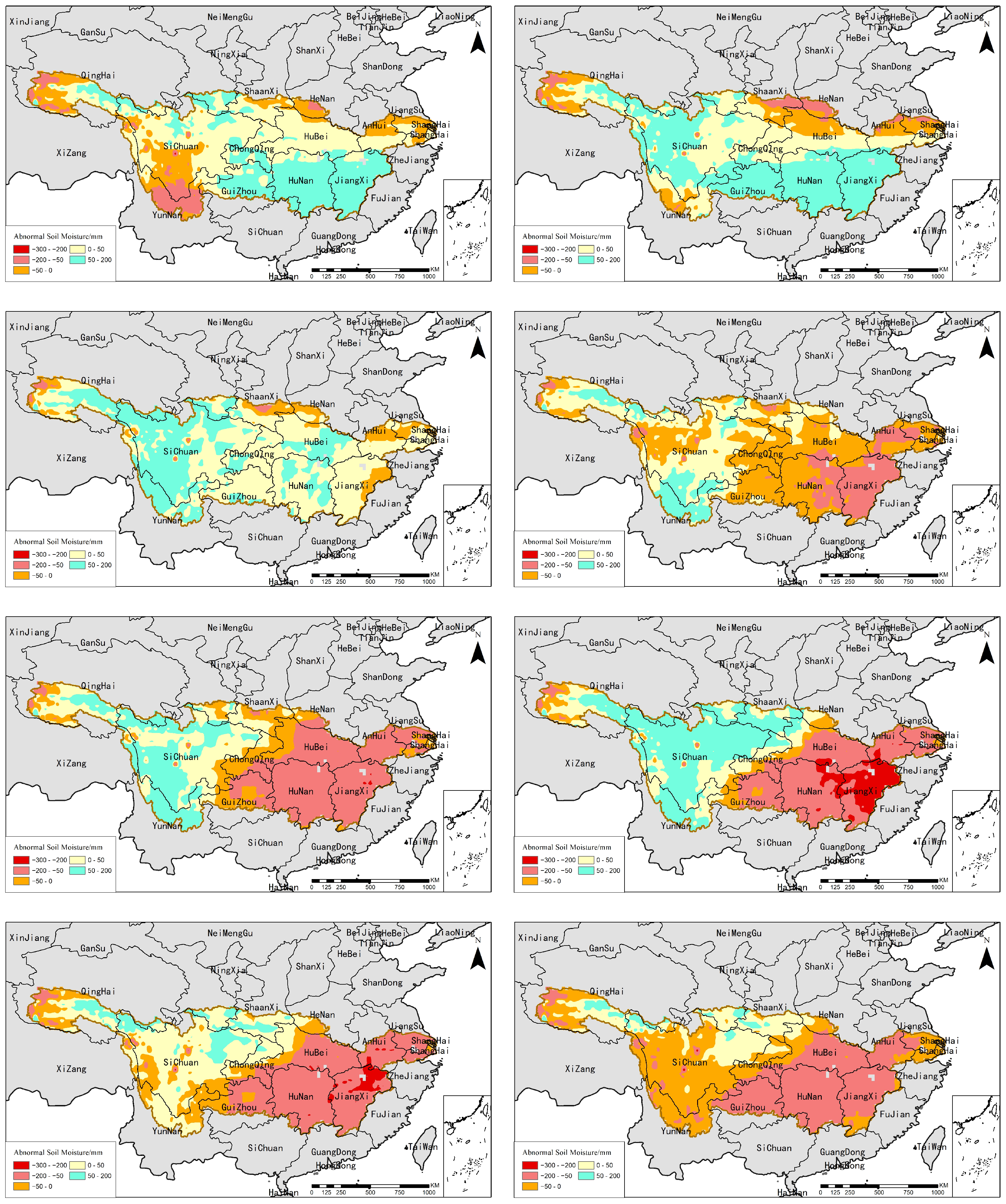
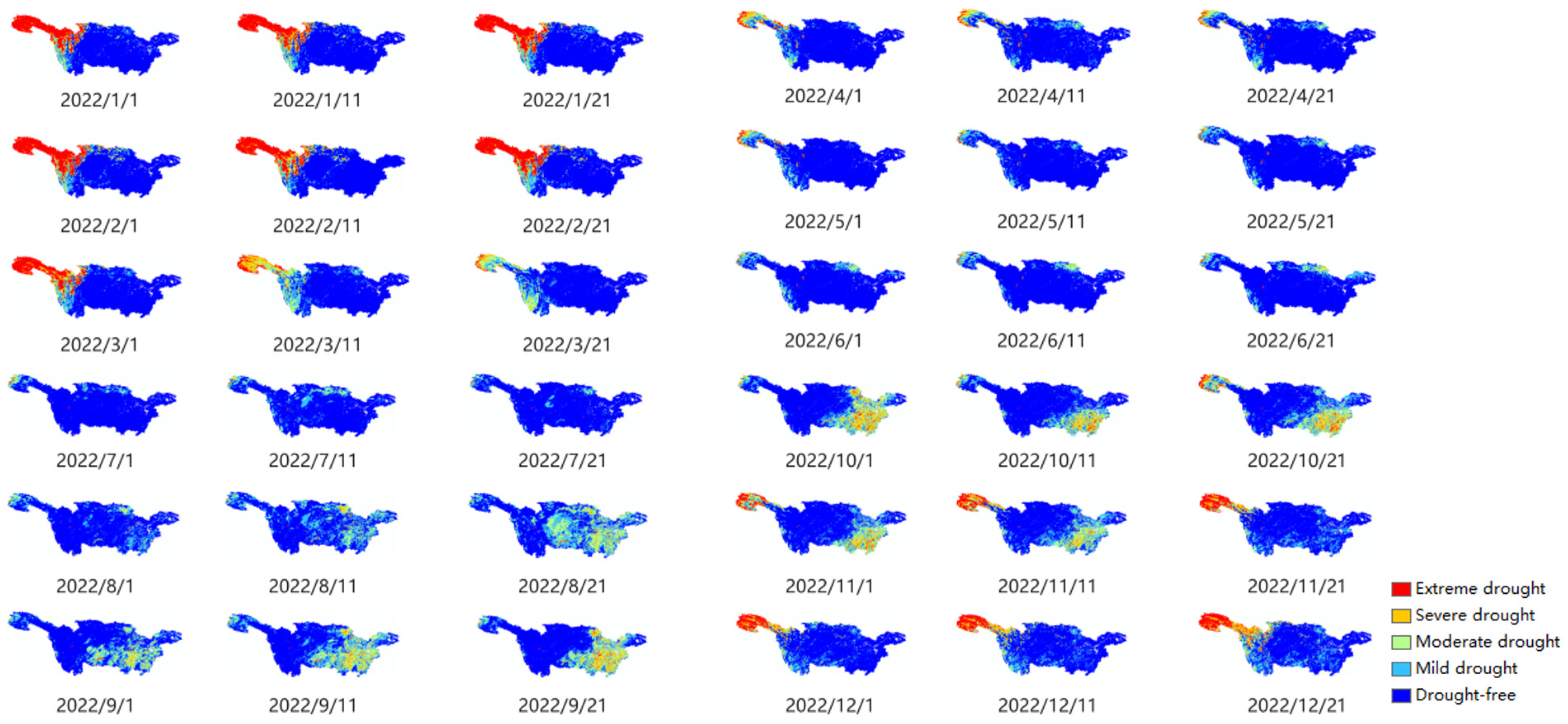
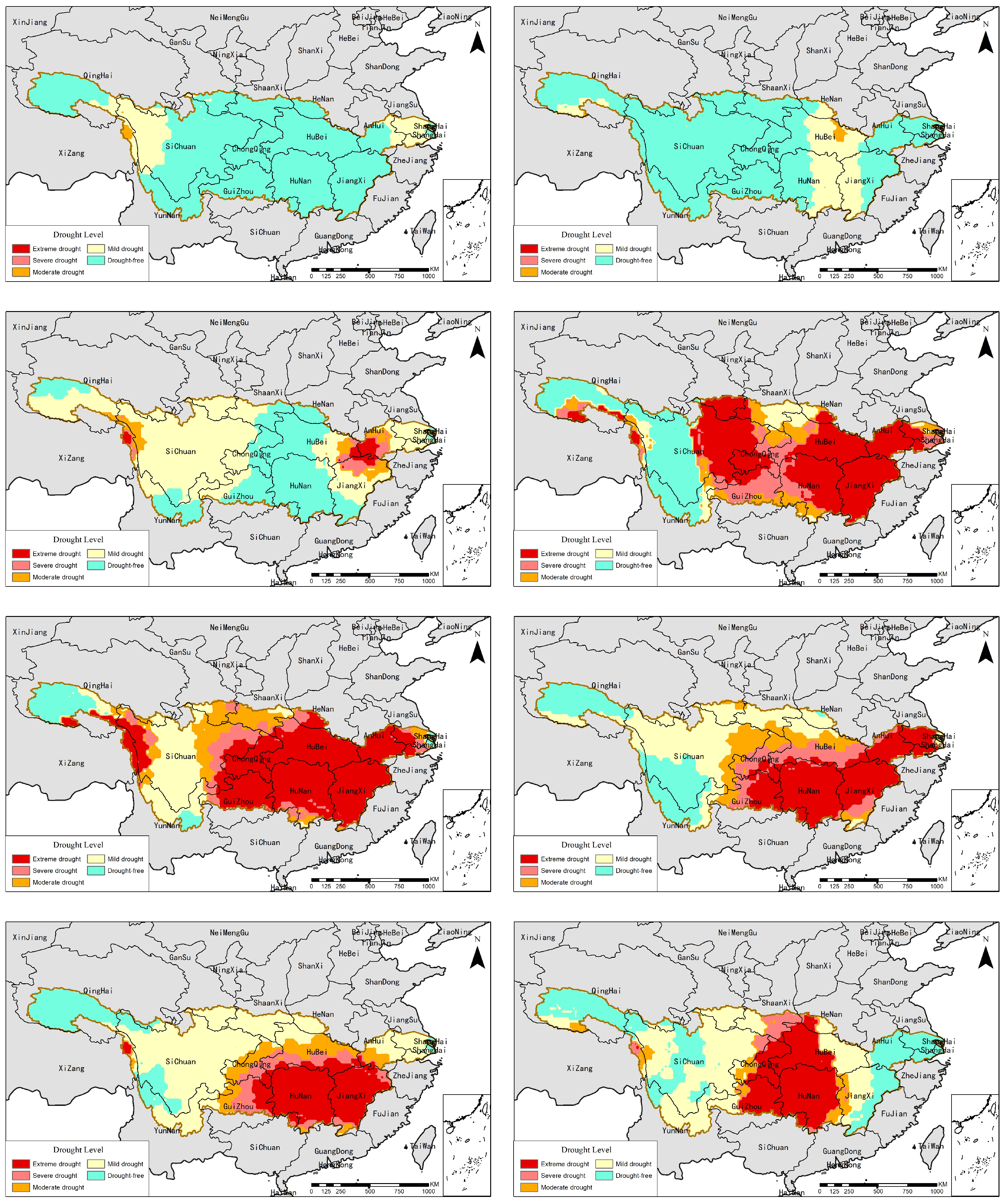
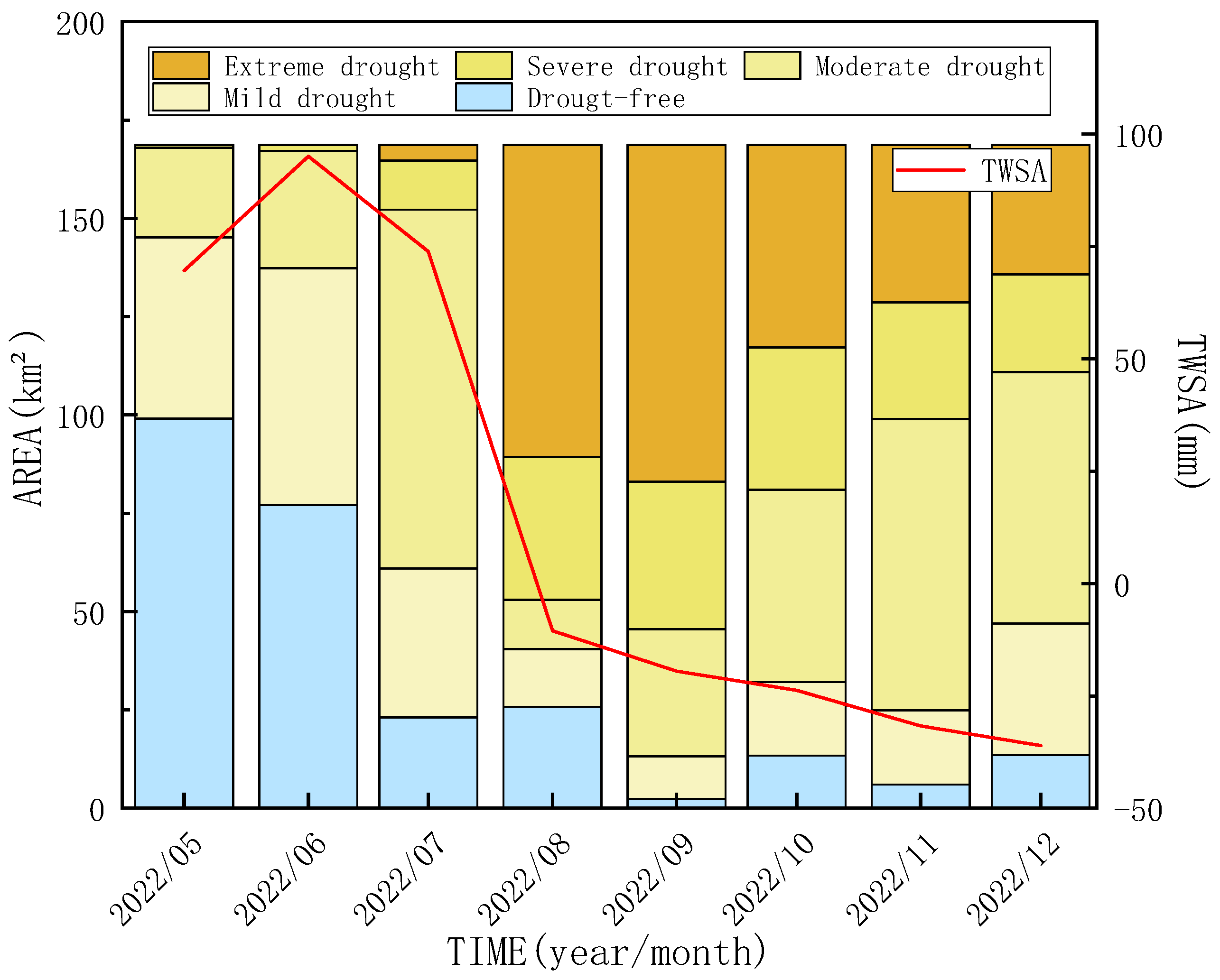

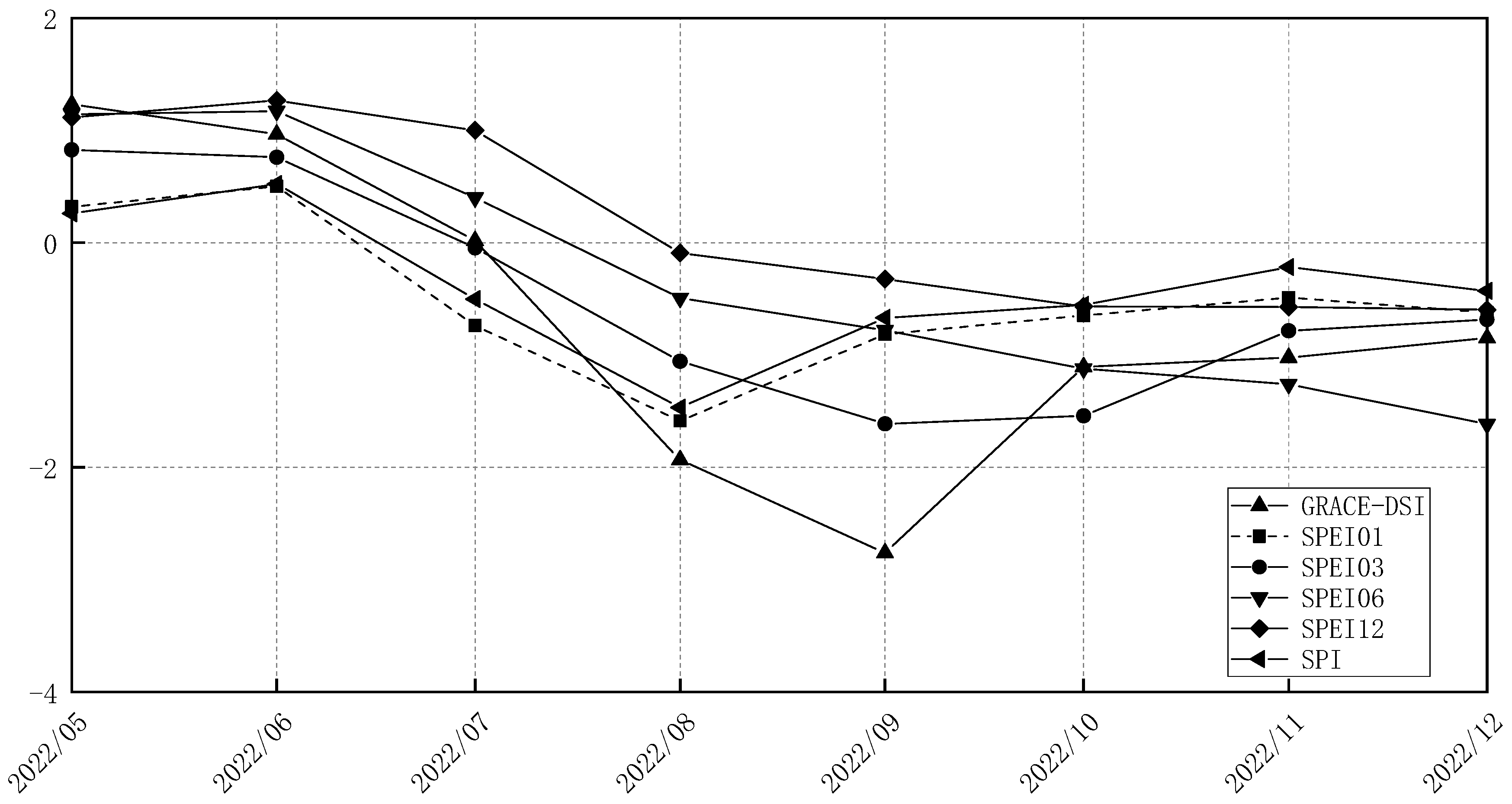

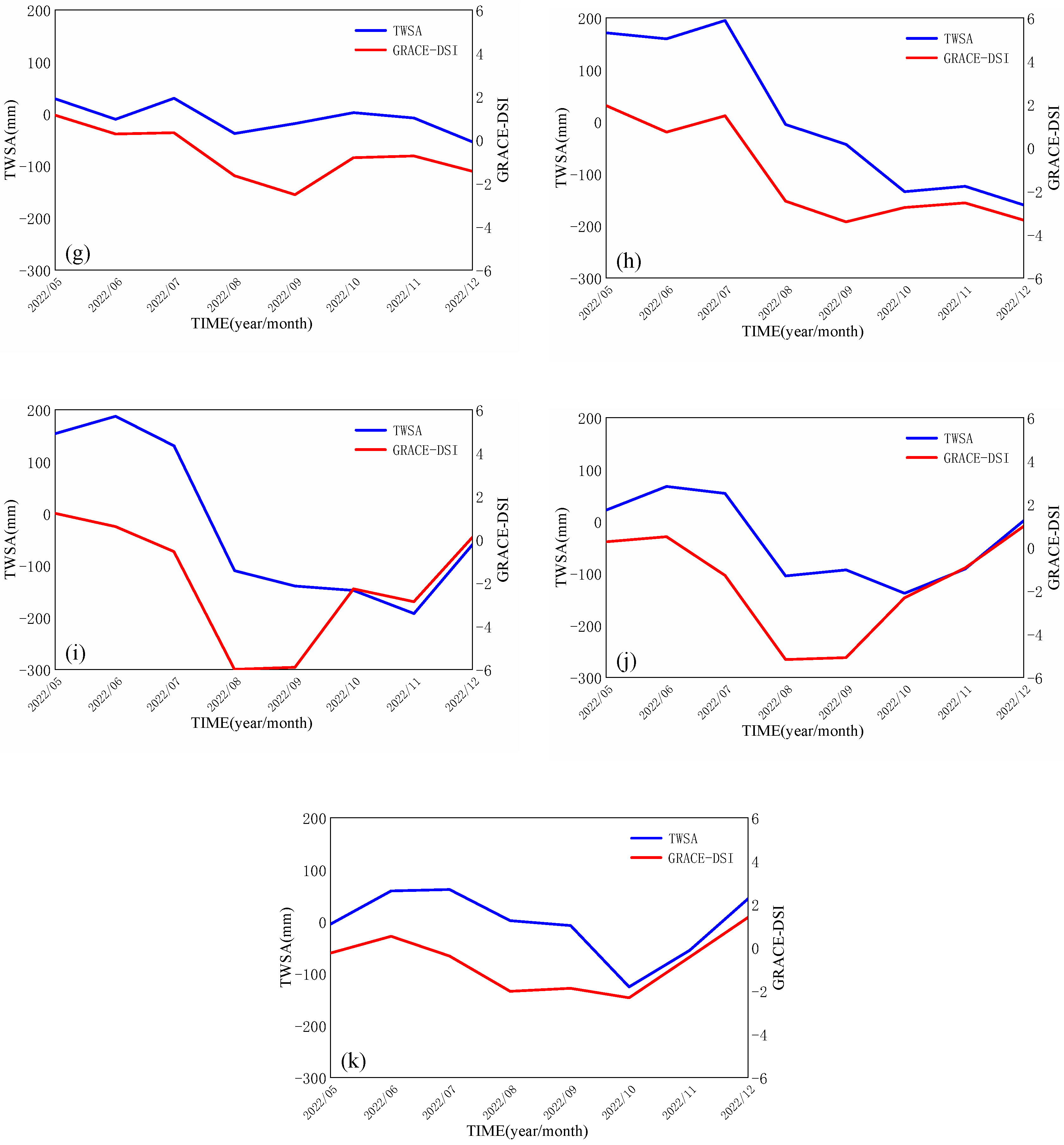

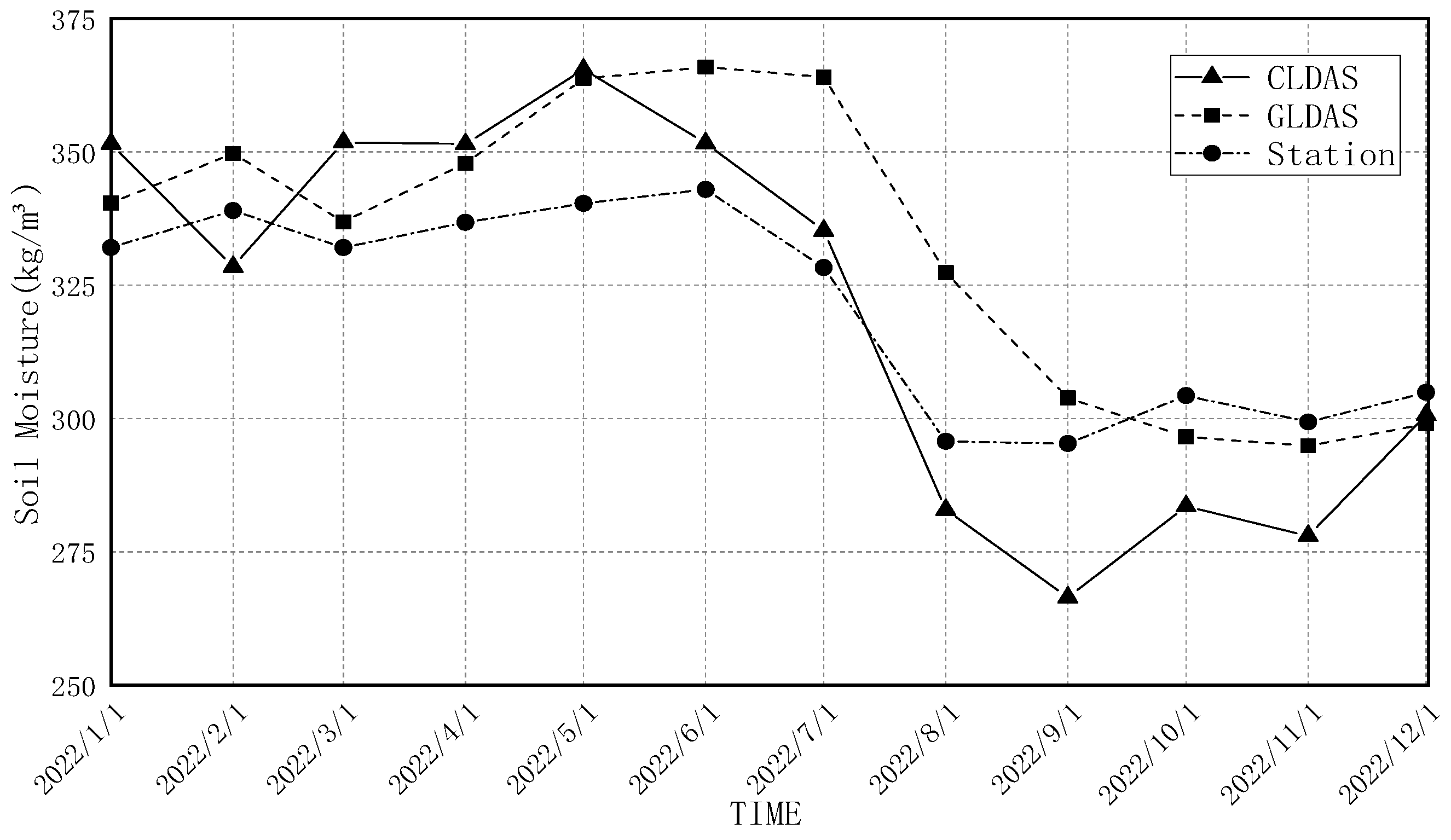
| Degree of Aridity | GRACE-DSI | SPI | SPEI | RSM |
|---|---|---|---|---|
| Drought-free | >0 | >−0.5 | >−0.5 | >60% |
| Mild drought | −1 to 0 | −1 to −0.5 | −1 to −0.5 | 50% to 60% |
| Moderate drought | −1.5 to −1 | −1.5 to −1 | −1.5 to −1 | 40% to 50% |
| Severe drought | −2 to −1.5 | −2 to −1.5 | −2 to −1.5 | 30% to 40% |
| Extreme drought | ≤−2 | ≤−2 | ≤−2 | 0% to 30% |
| R | GRACE-DSI |
|---|---|
| SPI | 0.79696 |
| SPEI1 | 0.81519 |
| SPEI3 | 0.93768 |
| SPEI6 | 0.74823 |
| SPEI12 | 0.78984 |
Disclaimer/Publisher’s Note: The statements, opinions and data contained in all publications are solely those of the individual author(s) and contributor(s) and not of MDPI and/or the editor(s). MDPI and/or the editor(s) disclaim responsibility for any injury to people or property resulting from any ideas, methods, instructions or products referred to in the content. |
© 2024 by the authors. Licensee MDPI, Basel, Switzerland. This article is an open access article distributed under the terms and conditions of the Creative Commons Attribution (CC BY) license (https://creativecommons.org/licenses/by/4.0/).
Share and Cite
Yu, M.; He, Q.; Jin, R.; Miao, S.; Wang, R.; Ke, L. Monitoring of Extreme Drought in the Yangtze River Basin in 2022 Based on Multi-Source Remote Sensing Data. Water 2024, 16, 1502. https://doi.org/10.3390/w16111502
Yu M, He Q, Jin R, Miao S, Wang R, Ke L. Monitoring of Extreme Drought in the Yangtze River Basin in 2022 Based on Multi-Source Remote Sensing Data. Water. 2024; 16(11):1502. https://doi.org/10.3390/w16111502
Chicago/Turabian StyleYu, Mingxiao, Qisheng He, Rong Jin, Shuqi Miao, Rong Wang, and Liangliang Ke. 2024. "Monitoring of Extreme Drought in the Yangtze River Basin in 2022 Based on Multi-Source Remote Sensing Data" Water 16, no. 11: 1502. https://doi.org/10.3390/w16111502
APA StyleYu, M., He, Q., Jin, R., Miao, S., Wang, R., & Ke, L. (2024). Monitoring of Extreme Drought in the Yangtze River Basin in 2022 Based on Multi-Source Remote Sensing Data. Water, 16(11), 1502. https://doi.org/10.3390/w16111502





